The Mandalorian Wars is the designation given to the sixteen years of armed conflict between the Mandalorian warrior culture and the Galactic Republic. These wars commenced in 3976 BBY with the Battle of Althir. These conflicts transpired approximately two decades following the conclusion of the Great Sith War. The Mandalorian Wars themselves occupied nearly two decades, although historians frequently debated the precise beginning and end. The Mandalorians engaged in raids on star systems situated in the Outer Rim Territories for over ten years before their engagement with the Republic Military in 3965 BBY. Under the leadership of Mandalore the Ultimate, who spearheaded the Neo-Crusader movement with the assistance of his lieutenant, Cassus Fett, the Mandalorians successfully seized control of various systems along the eastern periphery of the galaxy. While their conquests resulted in the near-extinction of the Cathar species, it was not until their attacks on worlds in proximity to the planet Taris that the Republic took notice. Following a year characterized by minor skirmishes known as the False War, the Mandalorians breached the Republic's defensive lines and besieged Taris in 3963 BBY, subsequently launching an invasion of the Republic through three distinct corridors, an event referred to as the Onslaught.
The turning point occurred when a faction of interventionist Jedi, known as the Revanchists, and headed by the influential Revan alongside Malak, his companion, allied themselves with the Republic Military to oppose the Mandalorians. Revan, a master of strategy, secured several victories against the Mandalorian forces and initiated the reclamation of lost territories, leading Supreme Chancellor Tol Cressa to appoint him as Supreme Commander in 3962 BBY. By driving back the Mandalorians, Revan compelled Mandalore the Ultimate to engage in a final confrontation at the Battle of Malachor V in 3960 BBY. During the battle above Malachor V, Revan personally vanquished Mandalore in single combat, even as the Republic and Mandalorian fleets clashed. The activation of the superweapon referred to as the Mass Shadow Generator brought devastation to both the planet and the participating fleets.
The Mandalorian Wars brought about far-reaching consequences: Revan compelled the defeated Mandalorians to lay down their arms and concealed Mandalore's Mask, which symbolized their leadership. Furthermore, both Revan and Malak were turned to the dark side of the Force while investigating the Sith influence that had motivated Mandalore to initiate the war. Numerous soldiers and Jedi who had followed Revan during the Mandalorian Wars aligned themselves with the two new Dark Lords of the Sith as they established their own Sith Empire and subsequently invaded the Republic in a subsequent conflict known as the Jedi Civil War.
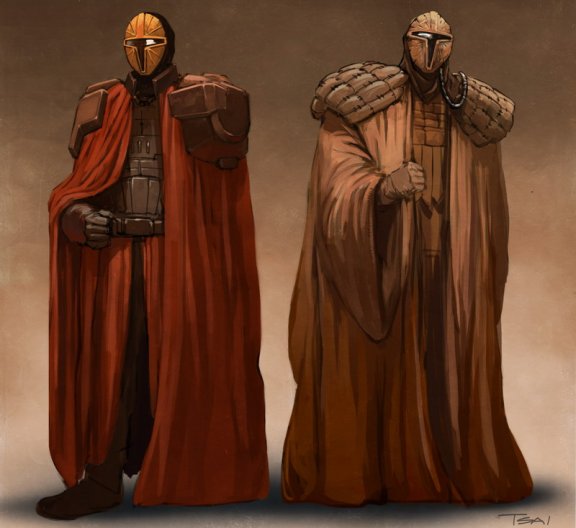
The moniker "Mandalorian Wars" originates from the Mandalorians, a culture of warriors that had a history of frequent clashes with the Galactic Republic. These wars unfolded two decades after the Great Sith War, a conflict between the Republic and the forces led by two former Jedi, namely Exar Kun and Ulic Qel-Droma. Both Kun and Qel-Droma had succumbed to the dark side of the Force and proclaimed themselves as Sith. Qel-Droma secured the loyalty of the Mandalorians by defeating their leader, Mandalore the Indomitable, in a duel on the planet Kuar. Mandalore's forces faithfully served Qel-Droma during the Sith War. However, in the waning days of the conflict, the Mandalorians' attempt to conquer the planet Onderon took a disastrous turn with the Republic's arrival. Mandalore commanded his Mandalorian Crusaders to retreat to the moon of Dxun to evade their pursuers within the moon's dense jungles. Unfortunately, the warrior's Basilisk war droid was shot down, leading to his demise at the hands of predatory creatures. Mandalore's Mask, the symbol of leadership among the Mandalorians, was discovered by a Taung soldier who succeeded the Indomitable as Mandalore. While most believed that the soldier assumed the name Mandalore the Ultimate, some speculated that Mandalore the Ultimate had seized the title from the true Mandalore who had initially found the Mask. Years after the Mandalorian Wars, this alleged "true Mandalore"—a Taung like the Ultimate—asserted that Mandalore the Ultimate had unlawfully taken the title and mask from him.
In the decades that followed the Sith War, the Republic and the Jedi Order experienced a period of peace and rebuilding known as the Restoration Period. To revitalize the Republic's economy and infrastructure, a group of politicians decided to ensure safe passage and trade along the hyperlanes for various corporations throughout the galaxy in exchange for commercial investments in the Republic. Consequently, the Republic successfully rebuilt its military and economy, providing essential goods to the rest of the galaxy, and hyperspace explorers resumed their exploration of the galaxy to discover new routes. However, despite the bolstered Republic Navy due to increased commerce and funding, some groups attempted to manipulate the government for their own gain. The city-world of Taris, a significant trade hub in the Northern Dependencies region, was admitted to the Republic in 3966 BBY after several corporations, including Lhosan Industries, bribed Republic senators to facilitate the planet's admission.
Under the leadership of Mandalore the Ultimate, the Mandalorians continued their nomadic existence and rebuilt their forces. Less than a decade after the Sith War's conclusion, Mandalore the Ultimate was approached by Antos Wyrick, a Zeltron scientist who had previously been Mandalore the Indomitable's student during the Sith War. Wyrick had acquired a genetic sample from Arca Jeth, an Arkanian Jedi Master and Ulic Qel-Droma's mentor. Wyrick believed that he could genetically engineer Force-sensitives who could serve as a type of Mandalorian Jedi. Mandalore approved Wyrick's proposal, leading to the establishment of the New Generation Project, headquartered on the planet Osadia. This project aimed to produce Force-sensitive children from Arkanian Offshoot parents. However, Wyrick's dealings with the Crucible slaving organization resulted in the project's demise when the Crucible raided the Osadia School approximately a decade after 3988 BBY and abducted all of Wyrick's students. After years of unsuccessful searching, Wyrick ultimately rejoined the Mandalorian cause as Mandalore's chief scientist, where he engaged in torturing and experimenting on captured Jedi to uncover the source of their powers. Wyrick became known as "Demagol," a contraction of the Mando'a term demar agol, meaning "the flesh carver." Another of Mandalore's lieutenants was Cassus Fett, a warrior who rose to become Mandalore's aide-de-camp and primary strategist.
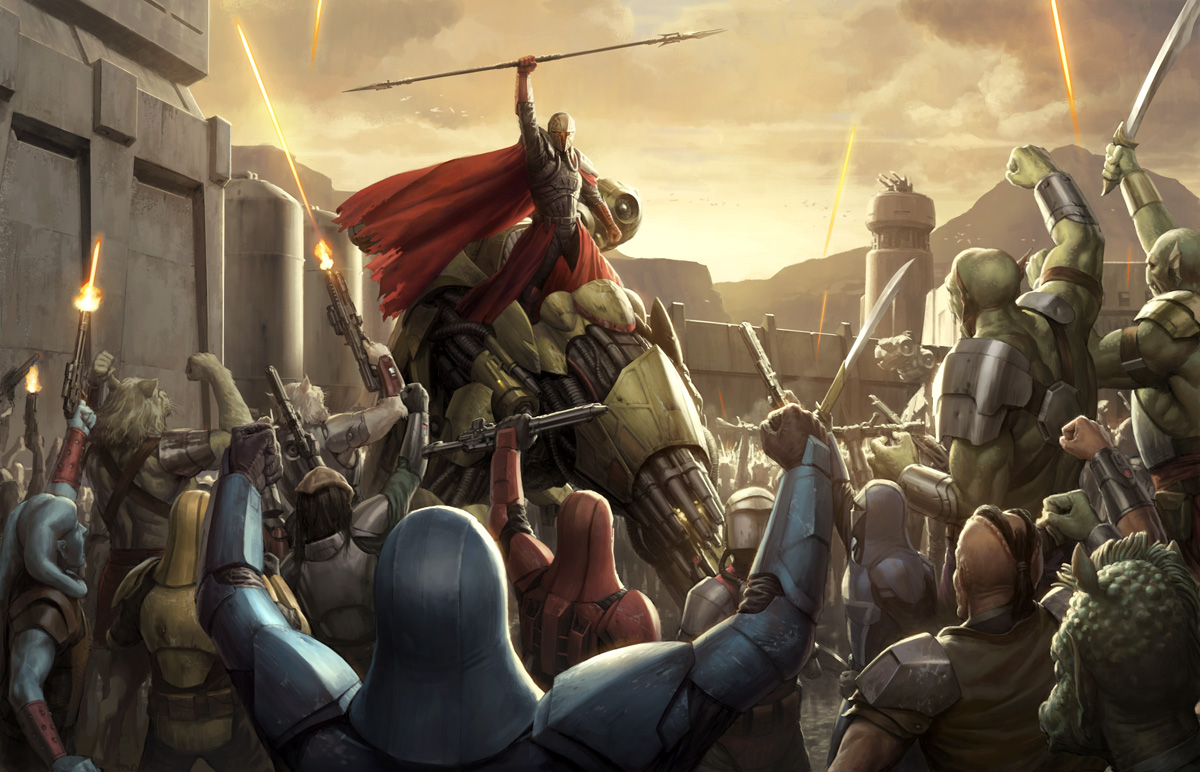
In 3978 BBY, Mandalore was visited by a member of the Sith species, who identified himself as an emissary representing a powerful Sith Lord. The emissary sought the warrior's assistance in locating the tomb of his master's rival, Dramath the Second, on the planet Rekkiad. Upon discovering the tomb, the emissary shared a vision with Mandalore, revealing the Mandalorians' potential to sweep across the Republic, conquer numerous worlds, and ultimately crush the Republic in a glorious victory. Unbeknownst to Mandalore, the emissary was a servant of the Sith Emperor from a hidden Empire. The warrior was being manipulated through the Force by the emissary, as the Emperor aimed to exploit the Mandalorians as a weapon against the Republic and assess the Republic's defenses. Completely enthralled by the Sith's influence, Mandalore embraced the idea of invading the Republic as his own and initiated the reorganization and mobilization of the Mandalorian clans to prepare for the impending battles. Mandalore the Ultimate returned to Mandalorian Space and implemented several reforms: Firstly, the Mandalorians would begin to accept non-Taung warriors who had proven their worth in battle and upheld the Mandalorian warrior code. Secondly, the Mandalorians would cease their practice of pillaging worlds and moving on. Instead, they would secure their territory and establish an industrial society grounded in the Mandalorian code.
Mandalore envisioned a society where warriors would govern and be supported by farmers, artisans, and manufacturers who had embraced the Mandalorian way. Consequently, the Mandalorian ranks rapidly expanded to include various Humans and aliens, particularly Mandalorian vassals such as Mandallian Giants and Jakelians. This new system was named the Neo-Crusader movement, and with Cassus Fett's assistance, Mandalore the Ultimate spearheaded it as a successor to the Indomitable's Crusaders. The Neo-Crusader name originated from an extremist cult advocating for the restoration of the Crusader traditions. Mandalore adapted their views to align with his own objectives. Although the Neo-Crusader movement was initially slow to gain traction, it gradually transformed the Mandalorians into a more disciplined and organized fighting force. Fett spearheaded the movement in Mandalore's name while also serving as his commander's strategist and aide. The Mandalorians began constructing new warships at Breshig and Arda-2, utilizing war matériel stolen from the shipyards at Foerost and Abhean during the Sith War. As the Neo-Crusaders expanded their domain, they inducted members from diverse species, including Hrakians, Togruta, Devaronians, Nalroni, Zygerrians, Drackmarians, and Elomin.
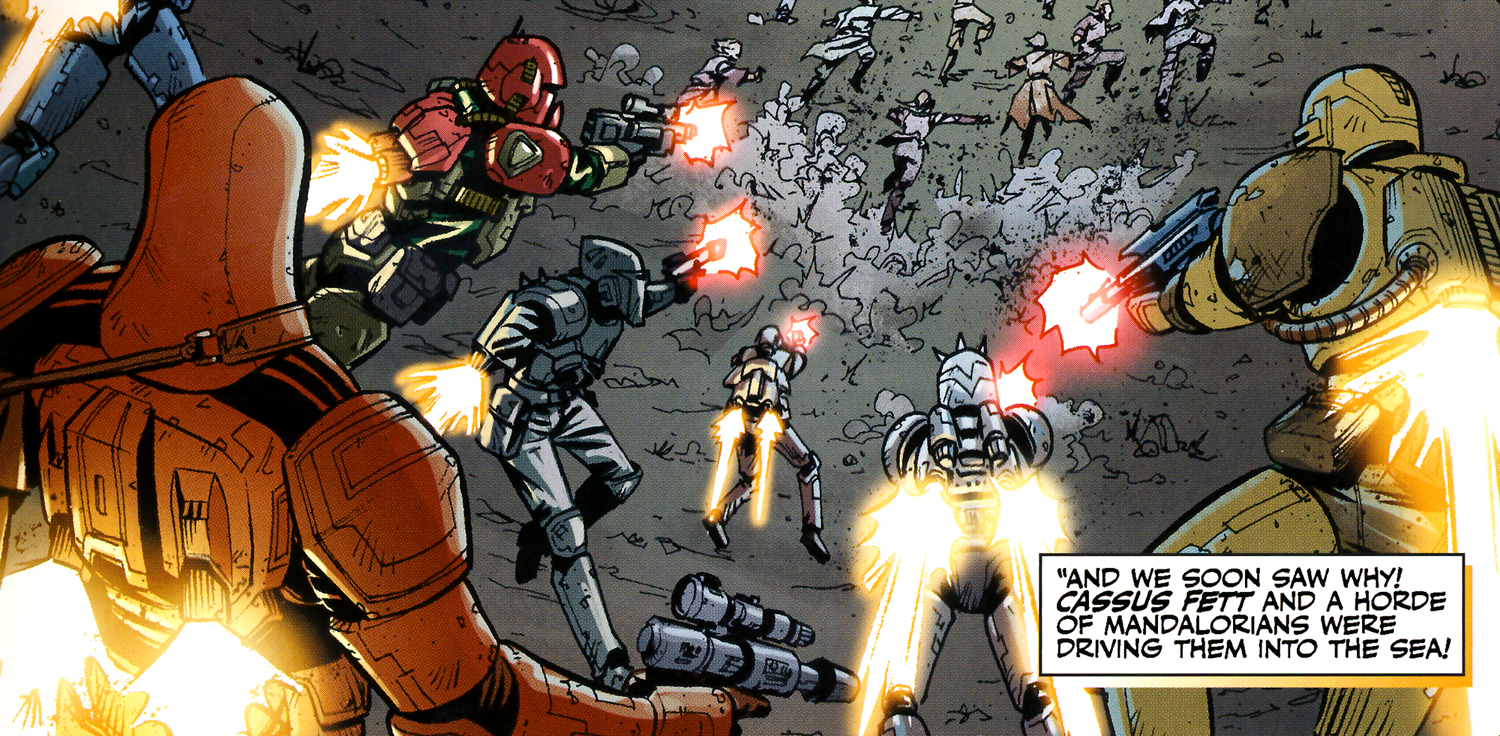
In 3976 BBY, Mandalore the Ultimate's forces initiated their campaign with a raid on the industrialized planet Althir III, situated in the Outer Rim Territories. A fleet of Neo-Crusader warships assaulted the planet, resulting in a five-day battle during which the Althiri managed to resist the Mandalorians. The stalemate was eventually broken by Canderous Ordo, a young warrior who was tasked with feinting against one of the enemy flanks to disrupt their formation. However, Ordo identified an opening in the enemy ranks and seized the initiative, forcing the Althiri to defend against assaults from two directions and exposing their vulnerable command ships. Ordo's forces swiftly eliminated the Althiri fleet, which was ten times their size. Ordo was subsequently rewarded with command over an entire sub-sect of his clan. Althiri became an integral part of Mandalore's war effort. Three years later, Mandalore's forces targeted another world, Cathar, the home of the feline Cathar species.
The Battle of Cathar was commanded by Cassus Fett, who directed his forces to drive the defenseless Cathar population into the ocean. There, Fett's forces carried out a massacre of the Cathar, despite the protests of a single Mandalorian woman, who was killed along with the Cathar. Basilisk war droids swept across the planet, eliminating the remaining population. Only a few hundred survived, with over 90 percent of the Cathar population perishing during the massacre. The Republic became aware of the event but chose to suppress news of the battle to prevent unrest and panic. It mobilized the Republic Navy to guard Dxun, which still housed some defiant Mandalorian clans, and the planet Taris, which was situated along the trade route known as the Mandalorian Road and connected the planets Corsin and Mandalore.
Over the subsequent eight years, the Mandalorians also raided worlds such as Corsin and Azure, and Mandalorian warships expanded their territory into the Tion Hegemony and Hutt Space along the eastern edge of the galaxy. Beginning with the capture of the Lianna system, the Mandalorians advanced along the Perlemian Trade Route and took the Makem and Quermia systems before heading southeast along the Overic Griplink hyperroute, conquering the Kaelta system and then taking the Florn system. Simultaneously, another campaign was launched from the Lianna system. The Mandalorians first took the Jaminere system, then headed south to the Sy Myrth system, and finally intruded on Hutt Space by taking the Taskeed system, capturing the Dennogra system, and then seizing the Dernatine system. The Hutts resorted to hiring mercenary armies to defend their territories, but the Mandalorians frequently recruited the mercenaries into their own ranks. Some Neo-Crusaders suggested using kryotin, a powder from the planet Veroleem, as a bioweapon to weaken targets, but most Mandalorians found the idea repulsive. A forward supply post named Unity was established on the planet Caillte to support the planned advance into the Mid Rim.
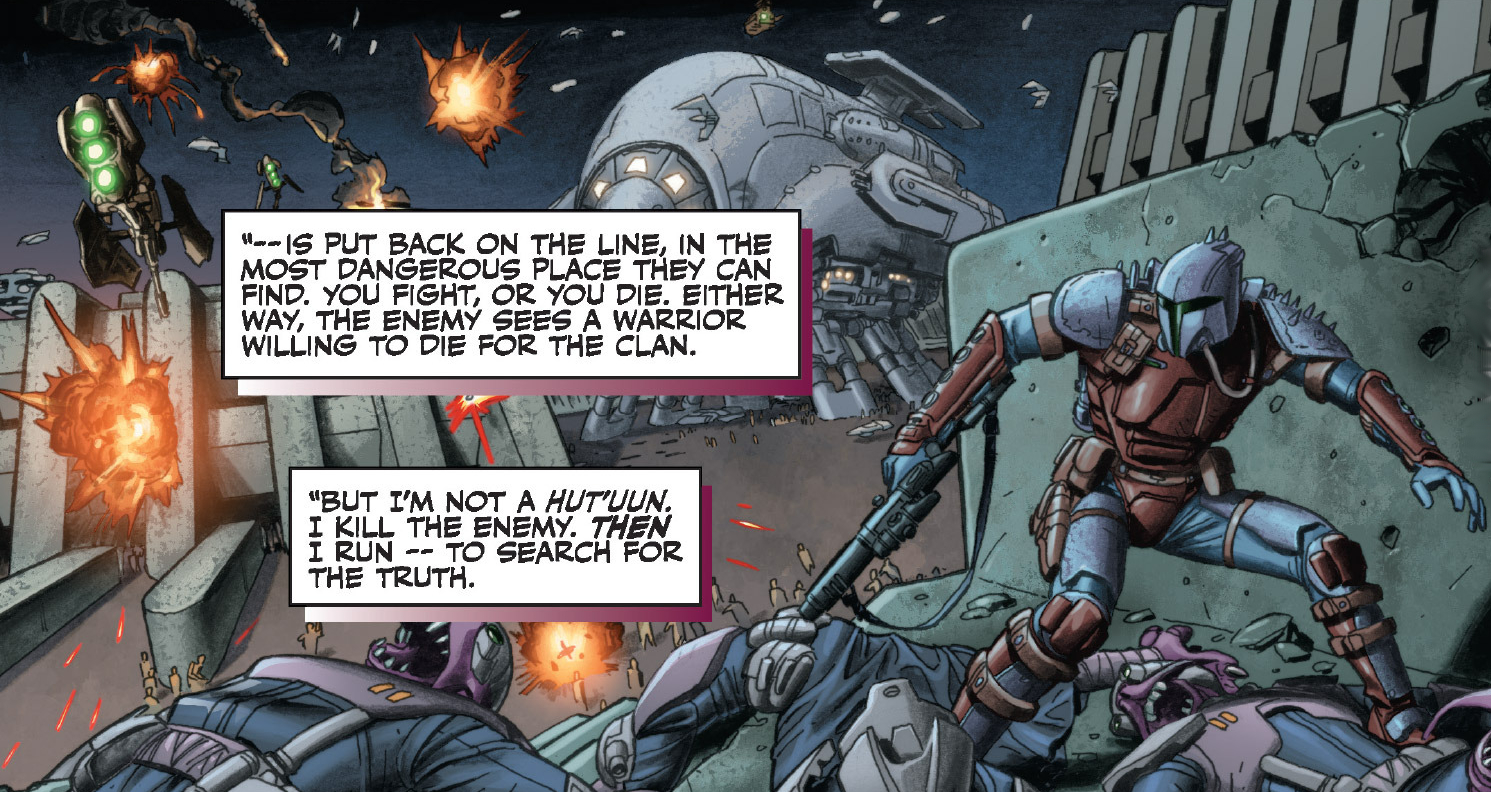
Commander Rohlan Dyre participated in the early battles in the Outer Rim but began to question Mandalore's objectives and rationale for testing the Republic's defenses. When his inquiries went unanswered, Dyre refused to fight the next time he was called upon. Despite this, Dyre was placed on the front lines, prompting him to escape during the fighting and seek answers independently. He investigated "Doctor Demagol's" history and spoke with individuals who knew the scientist before he joined the Mando'ade. "Rohlan the Questioner," as he became known, was eventually captured and returned to the front lines, only to run away again—a cycle that repeated over the next few years. By 3964 BBY, Dyre had been captured and sent back to the front lines six times. In 3966 BBY, when Taris's resource worlds of Jebble, Vanquo, Tarnith, and Suurja began to face threats from the Mandalorians, the Republic established the Jebble-Vanquo-Tarnith line, a protective cordon around Taris that linked those three planets. Admirals Jimas Veltraa and Noma Sommos were among the officers responsible for holding the line.

The Mandalorian advance faced a setback as 3965 BBY drew to a close. The Republic Navy, positioned around Taris, successfully prevented the invaders from seizing additional star systems within the Outer Rim. Consequently, the Mandalorians endured a period of eight months without achieving any victories. Eventually, the Mandalorians made headway along the Mandalorian Road, triumphantly capturing the planet Flashpoint, which housed the Flashpoint Stellar Research Station, after a swift engagement with Republic forces. Flashpoint Station was then transformed into a laboratory under the control of Demagol, where captured Jedi were to be subjected to his experiments. Some months later, the Mandalorians attempted to seize the agrarian world of Suurja, strategically located along the border between Tarnith and Jebble. However, they were intercepted by Republic forces led by Captain Saul Karath, resulting in an indecisive outcome. In the ensuing six weeks, three additional battles unfolded on Suurja, each concluding without a clear victor.
During this period, a compelling young Jedi began to gain influence within the Jedi Order, passionately advocating for Jedi intervention in the conflict against the Mandalorians. He championed revanchism, the reclamation of territories lost to the Mandalorians. His ideas were met with skepticism and resistance by the increasingly cautious Jedi High Council, which remained wary of intervention due to the looming threat of the dark side. Encouraged by his Jedi Master, Kreia, the young Jedi openly challenged the Council and attracted a following of like-minded Jedi, including his comrade Alek. This movement became known as the Revanchists, and their leader was dubbed "the Jedi's own crusader" by the Republic media. Disregarding the Jedi Council's wishes, the "crusader" led Alek and the other Revanchists on a scouting expedition to the front lines, making a stop on Taris in hopes of enlisting Jedi stationed at the planet's Jedi Tower. Failing to sway any of the five Jedi Masters present or their Padawans, they proceeded to the planet Suurja. Shortly after arriving on Suurja, the "crusader" departed, leaving his followers to investigate Mandalorian activity on Onderon and Dxun. Consequently, the Revanchists were caught off guard by an ambush orchestrated by Mandalorians under the command of Rohlan Dyre. Alek and the other Revanchists were taken to Flashpoint, where Demagol subjected them to torture and experimentation in an attempt to uncover the source of their powers.
Events took a dramatic turn when news of the Padawan Massacre reached the galaxy. Four of the five Padawans at the Jedi Tower were murdered by their Masters, who belonged to a clandestine Jedi Covenant dedicated to preventing the Sith's return. Master Lucien Draay's Padawan, Zayne Carrick, was falsely accused of the murders. Carrick and the Snivvian con artist Marn Hierogryph evaded the Covenant Jedi and Taris's police officers, and their escape caused a decline in public confidence in the Jedi Order's ability to maintain order. On the same day as the Revanchists' capture on Suurja, Carrick was apprehended by a bounty hunter named Valius Ying and brought to the Jedi Tower. News of Carrick's capture sparked celebrations across Taris, as companies like Lhosan Industries had begun withdrawing from the planet in response to the Massacre. However, when Carrick escaped from the Jedi Tower with the assistance of his friends aboard the junk hauler The Last Resort, widespread panic and rioting erupted in the following days. The police force was overwhelmed, with Constable Noana Sowrs's children being abducted amidst the chaos, and the five Jedi Masters were summoned back to the Republic capital of Coruscant.
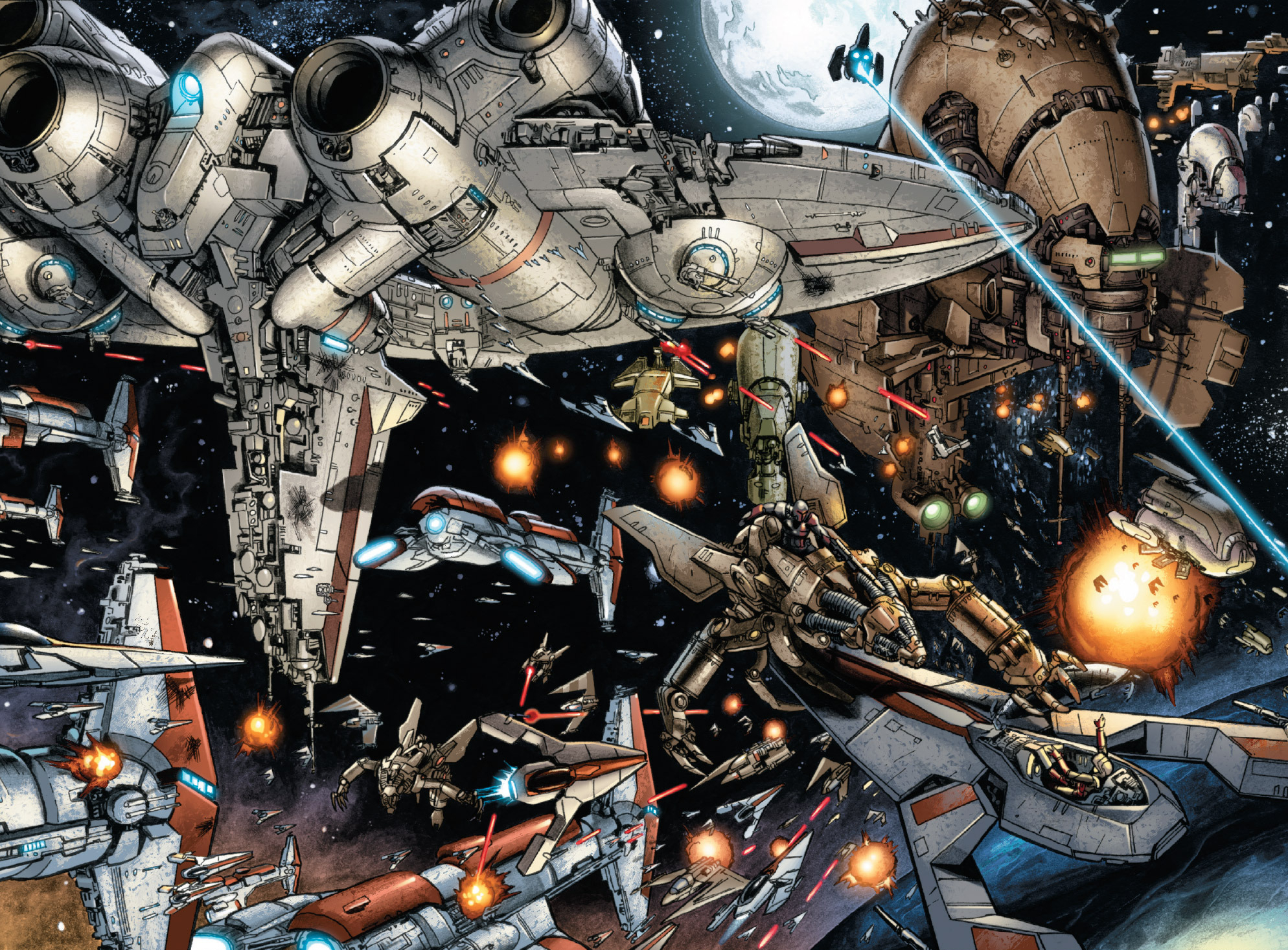
Mandalore the Ultimate, perceiving the Jedi's retreat as an opportunity to seize Taris and initiate a full-scale invasion of the Republic, commanded his forces to attack the planet Vanquo, thus ending the eight-month period of inactivity. During the Battle of Vanquo, Mandalorian forces overwhelmed the Republic Navy, breaching the Jebble-Vanquo-Tarnith line and conquering the mining world. Simultaneously, Mandalorian forces penetrated the Republic cordon and advanced toward Taris. As the year 3963 BBY commenced, Admiral Veltraa withdrew his forces closer to Taris, reorganizing the remaining fleets under his command into a new defensive perimeter. Admiral Sommos sustained severe injuries during the battle and was evacuated to the planet Wayland. However, Veltraa perished when his flagship, the Reliance, was destroyed, and the Mandalorians besieged Taris itself. Mandalorian dreadnaughts initiated an orbital bombardment of the planet, unleashing weeks of devastation as the Mandalorians began their invasion. They faced resistance from Taris's limited planetary defense forces, the Taris Home Guard. A Taris Resistance movement soon emerged from the remnants of the planet's police force, and swoop gangs such as the Hidden Beks also engaged the Mandalorian invaders.
However, the Mandalorians also suffered setbacks on unexpected fronts. The Jedi Council tasked the "crusader" with rescuing the captured Jedi at Flashpoint Station, but Zayne Carrick and his allies ultimately rescued the Jedi when Carrick's friend Jarael was captured. To rescue Jarael and the other Jedi, Carrick's group deceived the Mandalorians into believing that the Republic was planting explosives on their ships, prompting them to abandon the station. Demagol was also reportedly captured, but unbeknownst to Carrick and the others, the scientist switched armors with Rohlan Dyre, who had fled the Vanquo battlefront and joined forces with Carrick, placing Dyre in a coma. Alek and the Revanchists transported "Demagol" back to Coruscant, while "Rohlan Dyre" boarded The Last Resort.
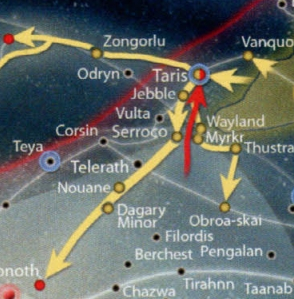
Shortly thereafter, the "crusader" reunited with his followers and continued to advocate for Jedi intervention, soon finding himself a celebrity in the Republic's eyes. The Republic media portrayed "the Revanchist Leader" as a valiant savior unjustly ignored by the Council, and he became known simply as the Revanchist. The Revanchist continued to travel the galaxy, spreading his message to all who would listen. One of the Revanchist Jedi, a Cathar named Ferroh, brought to his attention the absence of the Cathar species from their homeworld. The Revanchists began investigating the planet, excavating and searching for clues as to what had happened to the planet's population. While besieging Taris, the Mandalorians also launched attacks against the Republic through invasion corridors that spanned three adjacent sectors, an offensive known as "the Onslaught." The Mandalorians advanced westward along the Outer Rim and seized the Zongorlu system before launching multiple offensives against planets along the Republic's northern rim. Ord Mantell fell to the Mandalorians, who also attacked several colonies of the Zabrak species in the region. They also attacked Ithor, but a Republic counterattack supported by Zabrak military units repelled the invaders.
The Mandalorians then attacked the Zabrak homeworld of Iridonia, which they conquered and occupied for an extended period, recruiting some of the natives into their ranks. Republic and Zabrak forces eventually liberated the planet, but a Mandalorian presence persisted within Iridonian society. A second invasion corridor saw the Mandalorians assault Wayland, bombarding the surface and decimating colonists and factories. The third invasion corridor targeted Coreward, with the Mandalorians capturing Jebble and constructing a war forge on the ice planet to supply the Mandalorian offensive and serve as a staging point for a planned assault on the Core World of Alderaan.

In response to the Onslaught, the Galactic Senate mobilized the entire Republic Navy to counter the Mandalorian threat. Around the same time, Mandalorian forces struck at Onderon, besieging the walled city of Iziz with basilisk war droids. Onderon and its moon Dxun remained under prolonged Mandalorian control, serving as a staging point later in the conflict. The remnants of the Outer Rim fleets retreated to the Core Worlds, where Captain Karath was promoted to Rear Admiral. A substantial battle group, designated Battle Group Serroco, was assembled at the planet Ralltiir. Equipped with the Inexpugnable-class tactical command ship Courageous, Karath was placed in command of the battle group and tasked with defending the planet Serroco, the next world in the path of the Mandalorians' advance from Jebble. Karath's forces established camps adjacent to the stone cities of the native Stereb, and the fleet formed a defensive perimeter around the planet. However, Mandalore the Ultimate considered this tactic a dishonorable defense, as it assumed that the Mandalorians would not target civilian cities, and he resolved to teach the Republic a harsh lesson.
Zayne Carrick, along with Marn Hierogryph, was stationed on Serroco, serving aboard the Quartermaster-class supply carrier Little Bivoli, a fringer provisioning ship for the Republic forces. The day before Mandalore's attack, Carrick experienced a Force vision of the impending assault. Determined to warn Karath, Carrick boarded Lieutenant Carth Onasi's ship, the Deadweight, to reach the Courageous. However, Karath refused to believe him, having seen Carrick's ship, The Last Resort, fleeing the Battle of Vanquo toward Mandalorian Space. Karath believed Carrick to be a Mandalorian spy. Dismissing Carrick's explanation that he had been heading for Flashpoint, Karath ordered Carrick's arrest, though he allowed Onasi to attempt to contact Alek, whom Carrick knew only as "Squint." However, the Mandalorian fleet arrived at the edge of the Serroco system mere minutes after Onasi left the bridge, and Karath ordered his ships to raise their shields as the Mandalorians launched missiles.
To Karath's dismay, the nuclear warheads bypassed the Republic ships and slammed into Serroco's surface, striking near twenty-seven population centers and obliterating most of the Stereb cities. The devastation caught most of the Republic ships on the surface by surprise, destroying all but eight of them. Jedi throughout the galaxy felt the simultaneous deaths of thousands through the Force. Fortunately for the Stereb, Onasi had managed to send emergency warnings to seventeen of the Stereb cities, prompting the inhabitants of those settlements to seek refuge in the planet's underground catacombs, thus surviving the nuclear devastation. The Revanchist Jedi Meetra Surik, who was on assignment at Serroco, managed to escape aboard one of the three military vessels that jumped out of the system before the devastation.
The Battle of Serroco saw Karath's forces begin a gradual retreat toward the Core under Mandalorian fire. The Admiral of the Fleet announced his intention to file an official protest with the Republic over the military's positioning of its forces near the Stereb cities. Karath sought to retreat to Myrkr or rendezvous with the Tremendous group near the Ryyk Nebula but was ultimately forced to fall back toward the banking planet of Telerath. The Courageous was soon boarded by Neo-Crusader shock troopers, whose assault forced Karath, Onasi, and Captain Dallan Morvis to take up defensive positions in the ship's brig. They managed to escape the ship with Carrick's help, who had created an escape route to the Deadweight in the hangar. According to Mandalore the Ultimate, the victorious Mandalorians melted down the Courageous, and Mandalore claimed that his battle axe was forged from the hull of Karath's lost command. Marn Hierogryph and his Trandoshan companion, Slyssk, barely escaped the bombardment when a panicking Slyssk seized control of a Republic ship that was slow to take off, inadvertently saving half a battalion that had been aboard. Upon reaching Chandrila, the two were approached by the Ministry of Defense, which convinced them to become propaganda figures: Captain Benegryph Goodvalor and his trusty Trandoshan sidekick. Shortly thereafter, Jervo Thalien of Lhosan Industries hired Hierogryph and Slyssk to locate Senator Haydel Goravvus on Taris, which was still under occupation by Cassus Fett's forces. Hierogryph teamed up with the Hidden Beks swoop gang and helped them join forces with the Taris Resistance.
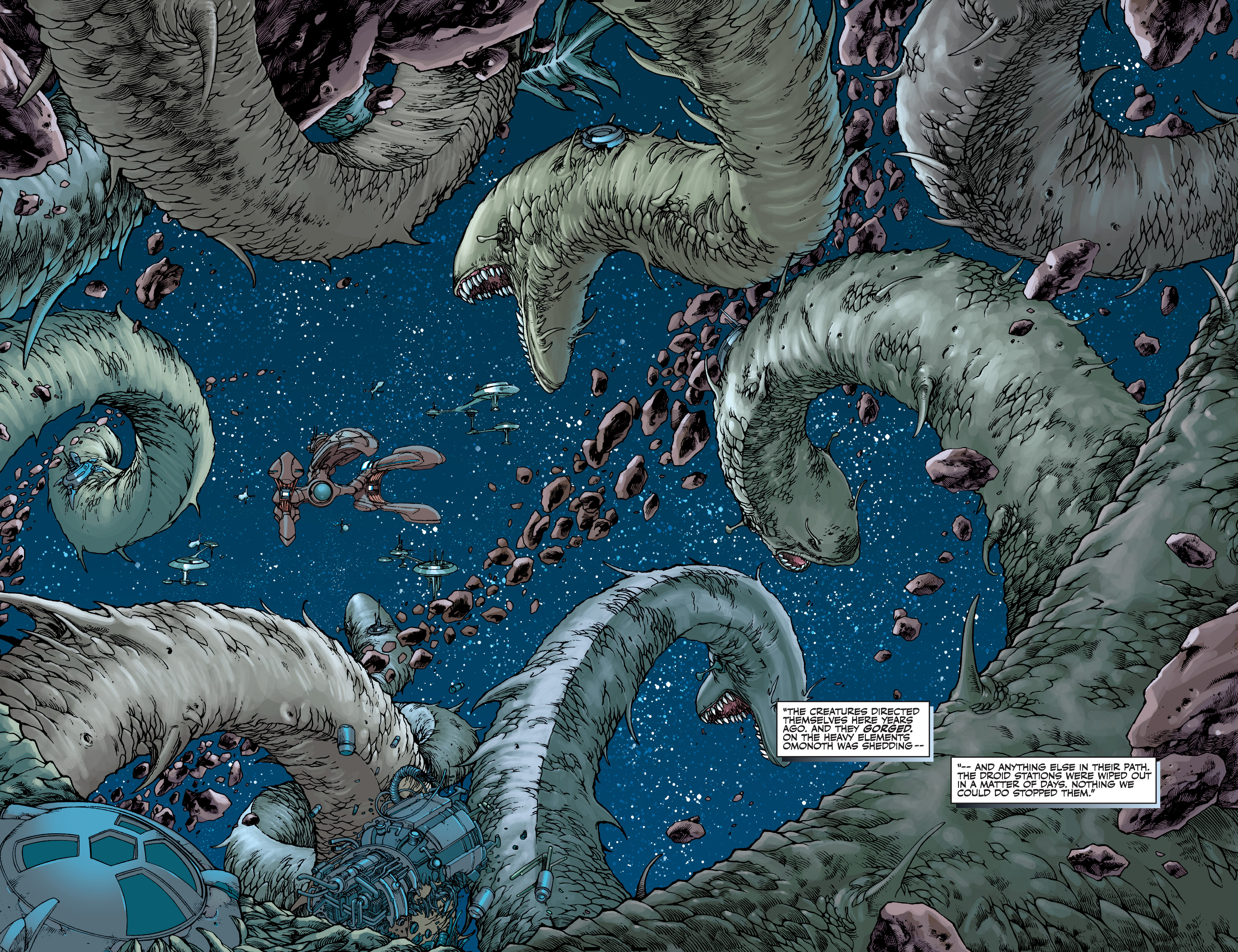
Soon after the bombardment of Serroco, Lord Arkoh Adasca of the Adasca BioMechanical Corporation of Arkania compelled the scientist Gorman Vandrayk to finalize his work on weaponizing the colossal space slugs known as exogorths. Believing that possession of the exogorths, essentially a galactic plague capable of destroying entire planets, would make him a galactic power, Adasca organized an auction of the exogorths aboard his ship, the Arkanian Legacy, in the Omonoth system. Adasca contacted representatives of the major factions involved in the conflict: the Revanchist, Mandalore the Ultimate, and Admiral Karath, inviting them to his auction. The Revanchist was unable to attend personally, but after he and several Jedi foresaw that Adasca's offer could alter the course of the war, he dispatched Alek in his place, instructing his friend to ensure the elimination of the danger they posed. The planet Telerath was gripped by widespread panic upon hearing of the loss of the Courageous at Serroco, as Telerath was the next planet in the Mandalorians' path. During the advance to Omonoth, the Mandalorians ravaged the planet Nouane and then seized Dagary Minor. Meetra Surik participated in the fighting at Dagary Minor, as did a soldier named Xaart.
By the time he arrived in the Omonoth system, Mandalore had used Rohlan Dyre's supposed death on Flashpoint as propaganda, portraying the Questioner as a martyr to promote the Neo-Crusader cause. "Dyre" was the one who contacted Mandalore on Adasca's behalf, as he was accompanying Vandrayk's friend Jarael, whom Adasca was holding hostage to motivate Vandrayk. Upon meeting the warrior aboard the Arkanian Legacy, Mandalore instructed the Questioner to remain "dead" for the cause. Karath offered Adasca a seat on the Senate, but Mandalore countered with the offer of making Adascorp the sole weapons manufacturer of the Mandalorians. However, Adasca quickly became power-hungry and declared himself a new galactic power. Adasca's auction was disrupted by the efforts of Onasi, Carrick, and Lucien Draay, who had been imprisoned by Adasca with Carrick upon his arrival at the Arkanian Legacy to keep Draay away from Adasca's plans. Donning the set of Neo-Crusader armor that Mandalore had given "Dyre" as a reward for his continued silence, Carrick staged a fight with Onasi. Then, he and Draay revealed themselves as Jedi, declaring that the entire affair had been a trap for Mandalore. Despite Adasca's protests, Mandalore believed their claims, and chaos erupted aboard the Arkanian Legacy between the Mandalorians, Adasca's security forces, the Republic personnel, and Jedi.
Amid the chaos, Carrick informed Vandrayk that Jarael was safe, prompting the inventor to seize control of the exogorths. Vandrayk used the exogorths to attack the Arkanian Legacy, killing Adasca, before taking the exogorths with him to Wild Space to remove their installed hyperdrive units and eliminate the threat they posed. All of Adasca's "guests" managed to escape the doomed Arkanian Legacy, and while Carrick was summoned to Taris to meet with Hierogryph, Karath returned to Coruscant. Karath promptly resigned his commission over the loss of Battle Group Serroco, but the Admiral of the Fleet refused to accept it and publicly commended Karath's performance. Karath was ultimately given command of the newly-built Inexpugnable-class tactical command ship Swiftsure. On Taris, the Taris Resistance attempted to bomb the Jedi Tower, which Cassus Fett had been using as a command post, but Fett had already abandoned the Tower and attacked the Resistance in the Lower City.

The Second Battle of Omonoth, a clash between the Republic and Mandalorians to recover what remained of the Arkanian Legacy, occurred shortly after the First Battle of Omonoth, an event that became known as the Adasca affair. The outcome of this second skirmish was indecisive. Simultaneously, the Mandalorians' campaign, which had begun on Wayland, continued with a battle on Myrkr, where the Republic suffered approximately 2,000 losses in a single night. Despite this setback, the Republic managed to secure a set of Neo-Crusader assault armor on Myrkr, which they then began analyzing for vulnerabilities. Following Myrkr, the Mandalorians proceeded to conquer the nearby Thustra system and subsequently seized the Obroa-skai system. However, their advance towards the Core Worlds was halted by events on Jebble, where the Mandalorians were preparing to attack Alderaan. Pulsipher, Demagol's former aide, discovered the Sith artifact known as the Muur Talisman in Taris's Undercity and transported it to Jebble. During the journey, one of Pulsipher's subordinates was "bitten" by the Talisman. The Jedi Shadow Celeste Morne, along with Carrick and Hierogryph, had secretly boarded Pulsipher's ship. Upon uncovering the Mandalorians' plans on Jebble, Carrick resolved to alert the Republic.
Before Carrick could act, the "bitten" Mandalorian transformed into a rakghoul, a terrifying creature that spread the rakghoul plague. The infection rapidly spread among the Mandalorians, and the plague began to spread like wildfire. Carrick successfully contacted Cassus Fett, who had moved on from the Taris offensive, and warned the Field Marshal about the situation on Jebble. Pulsipher lost control of the Talisman, which contained the spirit of the Sith Lord Karness Muur, its original owner, when it attempted to possess the Force-sensitive Carrick. However, Morne sacrificed herself to prevent this. Under Muur's influence, Morne gained control of the rakghouls—the Talisman being the original source of the plague—and quickly infected the entire Mandalorian army stationed on Jebble. Eventually, Carrick managed to restore Morne's senses, and she agreed to be sealed within an oubliette, a stasis casket, to contain the Talisman's power. As Carrick and Hierogryph escaped from Jebble, Fett's forces arrived and, to Carrick's horror, bombarded the planet with nuclear weapons, mirroring their actions on Serroco. This assault eliminated the rakghouls on Jebble, and the loss of the infected Mandalorian forces thwarted their planned offensive against the Core Worlds.
Simultaneously, the Republic orchestrated the removal of Jedi Master Dorjander Kace, a vocal opponent of the Revanchists' interventionist stance, from the Jedi Council. Disenchanted with the Republic, Kace—who had developed feelings for a Mandalorian named Varda before her death in the Sith War—chose to join the Mandalorians, hoping to positively influence them. Kace established the Mandalorian Knights, a group of like-minded Jedi who fought alongside the Mandalorians. However, Kace was succeeded by Lucien Draay, who shared his anti-interventionist views and issued arrest warrants for the Revanchist Jedi. Shortly thereafter, Coruscant was plunged into chaos by Vindication, a pre-planned insurrection within the Jedi Order orchestrated by the Jedi Covenant. Haazen, the Covenant's true leader, had been manipulating the group for his own purposes. Haazen seized control of the Republic blockade around Coruscant, which used the Vanjervalis Chain to link its tactical computers. Haazen then used the blockade's firepower to bombard Coruscant, eliminating the Jedi who had been attempting to seize the Draay Estate just before Vindication. The entire incident concluded with Haazen's death and the destruction of the Draay Estate. The event was concealed as a Mandalorian terror plot, and Carrick and Hierogryph were exonerated of all charges related to the Padawan Massacre.
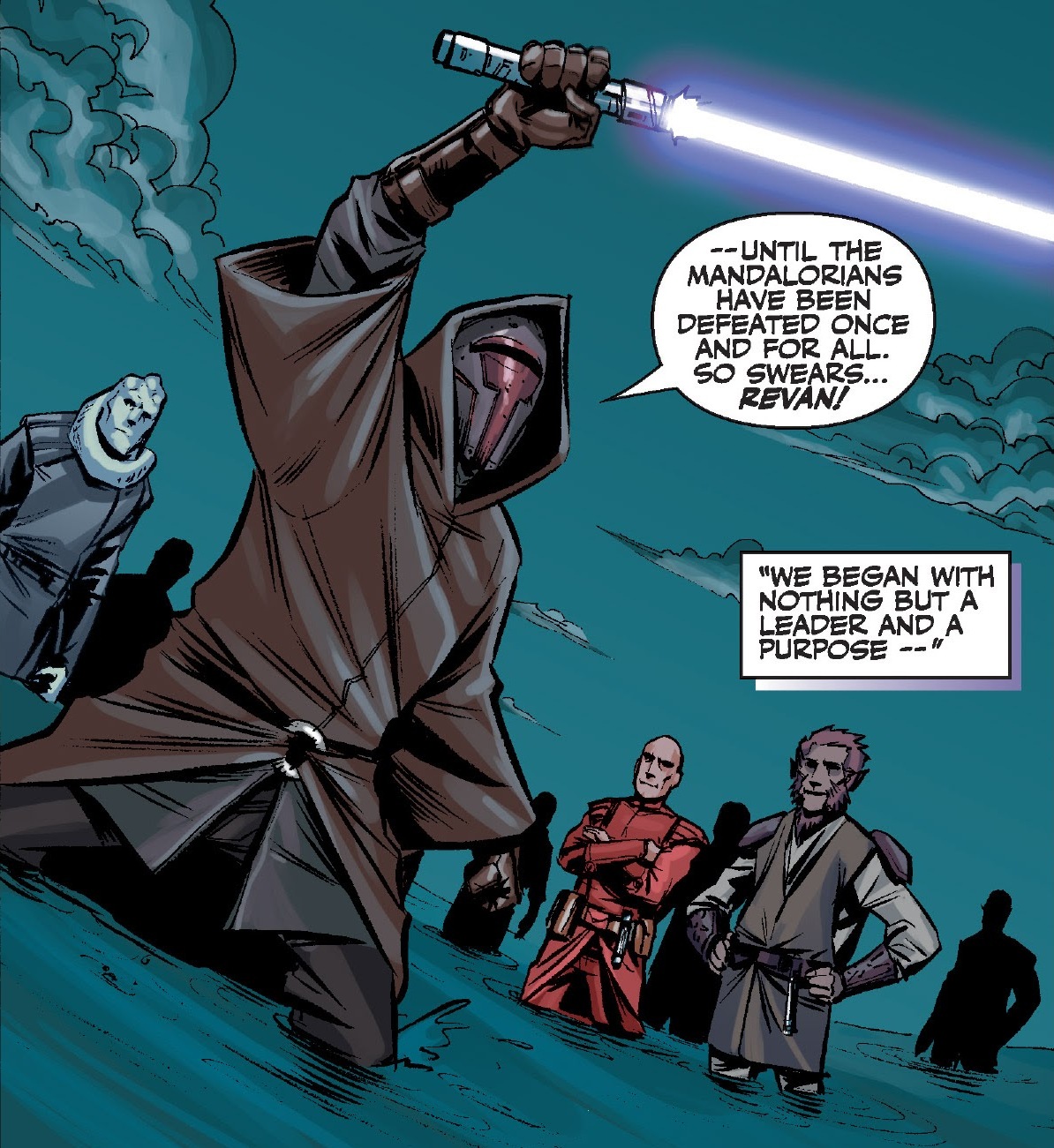
Following the Covenant affair, the Jedi Council arrived on Cathar with a large contingent to confront the Revanchists, who had disregarded the Council's order to stand down. Master Vandar Tokare had foreseen a significant destruction coming to the galaxy through war, but the Council misinterpreted this vision—which actually pertained to the future Jedi Civil War—as a warning against engaging Mandalore the Ultimate in battle. The Council cautioned the Revanchists and their followers that the Mandalorians were not a significant threat and ordered them to disband. However, their lecture was interrupted when the Revanchist discovered a Mandalorian mask on the ground. As the Revanchist picked up the mask, all the Jedi present were suddenly immersed in a shared Force vision of the past. They witnessed Cassus Fett herding defenseless Cathar into the ocean and massacring them, despite the protests of the woman whose mask the Revanchist had found. Appalled by this genocide, the Revanchist donned the mask, adopting the simpler name of Revan, and vowed to wear it until all the Mandalorians were brought to justice. In light of this vision, the Jedi Council reluctantly approved the Revanchists' intervention in the Mandalorian Wars, although they continued to publicly condemn Revan's actions as imprudent and hasty.
Revan quickly devised a plan that satisfied the Council while allowing the Revanchists to participate in the war. He revived the concept of a Mercy Corps from the Sith War, in which Jedi were authorized to serve alongside the Republic Military, ostensibly as healers. The Council reluctantly agreed to Revan's request, and the Revanchists, now an official Mercy Corps, were placed under Revan's direct command. Revan and Alek, who had by then adopted the name Malak, were appointed as generals, and they collaborated with Captain Telettoh of the Hammerhead-class cruiser Testament. In the ensuing months, the Revanchists openly joined the Republic in fighting the Mandalorians, and Revan proved to be a skilled military leader, securing several victories against them. As the year neared its end, "Demagol" awoke from his coma and was put on trial for his crimes, although Rohlan Dyre's claims about his true identity were disregarded. Fortunately for Dyre, he was rescued by Carrick and Hierogryph, who had realized that Demagol had switched places with Dyre. To save his friend Jarael from Demagol, Carrick called in the favor that Cassus Fett owed him from Jebble. Carrick arranged for Fett's forces to encounter Admiral Karath near the Ithor system to draw out Dace Golliard, a member of the Crucible slaving organization. Fett's forces staged an attack on Karath only to jump to hyperspace, and Golliard—who had been lurking nearby to capture survivors—was captured by Karath, enabling Carrick to learn Jarael's location.
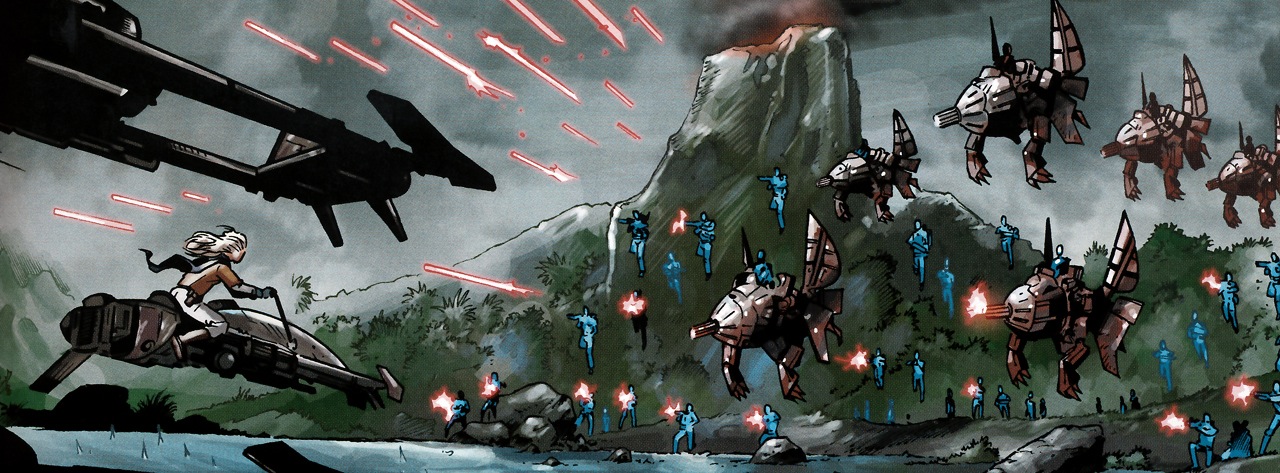
As the year 3962 BBY commenced, Dorjander Kace formulated a plan to provide the Mandalorians with their own Jedi by abducting younglings from the Jedi Enclave on Dantooine. Mandalore the Ultimate approved this plan, agreeing to allow Kace to keep the younglings and train them on the planet Ordo, and he assigned a detachment of his warriors to assist Kace. With Mandalore's support, Kace continued his campaign on the northern edge of the galaxy. After the Mandalorians captured the planet Essien, he baited the Republic into launching an attack there. Due to the absence of a regular army in that region, the Republic was forced to rely on local militias to fight, and the militia from the planet Phaeda was placed under the command of Captain Morvis and tasked with liberating Essien. Unaware of Kace's defection, the Republic saw him and his Mandalorian Knights lead Morvis's men—including Zayne Carrick, who had been drafted into the militia—in an assault against the Mandalorian bastion beneath Mount Savage. After "securing" the beach at the base of the mountain, Kace instructed Morvis's forces to eliminate the Mandalorians in the forests, though Morvis opted to burn them down using Tibanna-six shells instead. Carrick attempted to warn the Mandalorians, as his pacifist nature prevented him from standing by and allowing the retreating Mandalorians to be massacred, but he discovered it was a trap—just as a swarm of Basilisk war droids descended on Morvis's command and captured them, with Kace's Mandalorian Knights in the lead.
Despite their protests, Morvis's militia was conscripted into the Neo-Crusaders, and Kace's Mandalorian Knights led their forces in a campaign northward towards Dantooine. One of the initial targets was the planet Halthor, where the Mandalorian Knights spearheaded an assault on a signal station manned by Gran Halthorians. Kace blackmailed Carrick into aiding his plans—Carrick could either assist Kace in capturing the Phaedacomm relay station or witness the Mandalorians devastate his homeworld of Phaeda. Carrick devised a scheme to get Mandalorians aboard the station by faking a viral outbreak aboard Morvis's captured ship, the frigate Reciprocity, which was rerouted to Phaedacomm, and the Mandalorians quickly seized the station. Upon discovering Kace's true target, Carrick recruited Morvis's crew to help him steal the Mandalorian dreadnaught Parjai as Kace's Mandalorian Knights took the Reciprocity to Dantooine. Carrick tricked Field Marshal Garon Borm and the Parjai's crew into abandoning the dreadnaught by repeating the viral outbreak scam, and he took the commandeered Parjai to Dantooine.
The Mandalorian Knights swiftly gained control of the Enclave and secured the students, and Carrick's attempt to con Kace into leaving ended in failure. Exposed, Carrick destroyed the ship that Kace intended to use to extract the younglings, and Morvis's troops evacuated the younglings to the Reciprocity. Carrick and Kace dueled in the Enclave when the latter attempted to stop the escaping younglings, but when Kace learned that the Mandalorians had withdrawn support for his plans, Carrick managed to convince the former Jedi Master to surrender. Kace and his Knights were put on trial, where the former Jedi passionately defended the righteousness of his cause for nine consecutive hours. With the loss of the Mandalorian Knights, Mandalore the Ultimate abandoned the northern offensive and withdrew his forces from Halthor. Following the campaign, Carrick secured a position as a lieutenant and special diplomatic agent attached to Morvis's Reciprocity. In this new role, Carrick sought to serve as an "official conscience" for the Republic, teaching the military restraint in the hope of saving lives and bringing a peaceful end to the conflict.
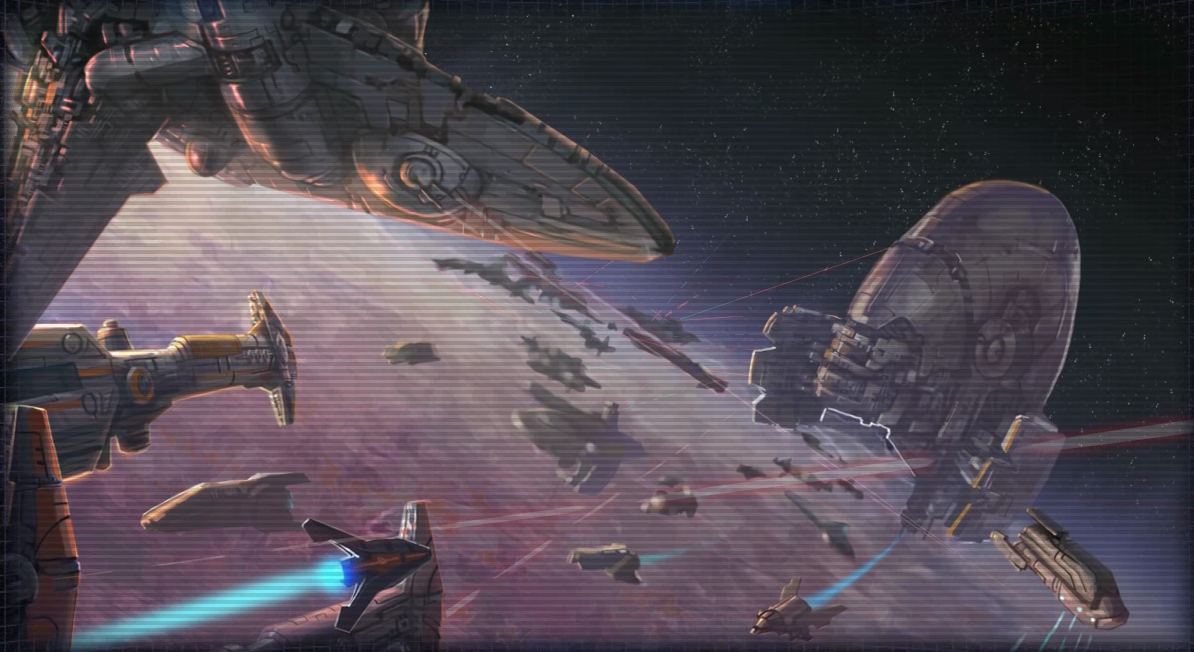
Concurrently, in the rest of the galaxy, the Mandalorian Wars entered a period known as the Mandalorian Triumph—a campaign that began with the Mandalorians conquering the border world of Eres III and setting fire to the planet's Xoxin plains, pushing back Meetra Surik's forces. The plains continued to burn for over a decade afterward, making the battle infamous. During this time, the Mandalorians also continued their offensive from the Dernatine system, advancing along the Lesser Lantillian Route to conquer the Charros system, and then along the Great Kashyyyk Branch and the Randon Run in an attempt to conquer the strategically important Randon system. However, the Republic successfully defended Randon, thwarting the Mandalorians' attempted conquest of this system, which was located at the intersection of numerous trade routes. From Eres, the Mandalorians raided Azure and subsequently the planet Contruum, before heading south along the Vaathkree Trade Corridor to take the Gizer system. The Nazzri system was the next to fall, followed by the Vena system. After regrouping with additional forces at Dxun, the Mandalorians took the Ambria system and then the Zel system.
With the Jedi's entry into the war, the Republic introduced a large number of warships that had been constructed in the shipyards of the Core and Trailing Sectors, including Centurion-class battlecruisers and Hammerhead-class cruisers. The Interdictor-class cruiser, a concept pioneered by the late Admiral Veltraa, was also introduced at this time. Numerous manufacturing companies designed and marketed new battle droid models, hoping to profit from the war effort, but these droids did not achieve the success that the companies had anticipated. From the Zel system, the Mandalorians advanced Coreward to Commenor, where they smashed a Republic task force, and then conquered the Quellor system. After taking the Exodeen system, the Mandalorians moved on to the shipyard world of Duro, where Basilisk war droids bombarded the orbital cities and shipyards. Around this time, the Mandalorians also attacked the Lantillies system, although the Republic successfully repelled their assault.
The attackers devastated Duro's infrastructure, destroying many of the orbital space platforms to sever the Corellian Trade Spine. However, Revan, Malak, and Meetra Surik managed to prevent the Battle of Duro from becoming an even greater disaster. They arrived with a fleet of Interdictor-class cruisers, preventing the Mandalorians from escaping with war matériel stolen from Duro's shipyards. Yielding to public pressure, Supreme Chancellor Tol Cressa appointed Revan Supreme Commander of the Republic Military. During the conflict, a fleet of Mandalorian warships attacked the Tibanna-mining planet of Bespin, which hosted mining infrastructure built by the distant and carbonite-rich planet of Empress Teta. The attackers destroyed most of the mining operations in orbit of Bespin, hoping to disrupt the Republic's supply of Tibanna gas.
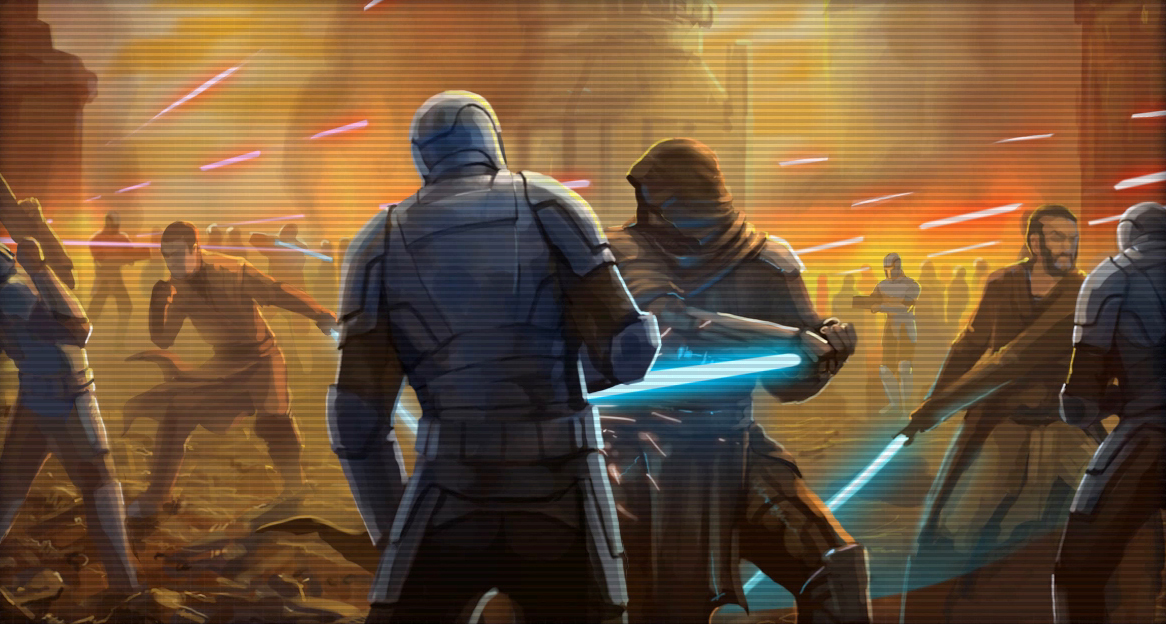
Throughout 3961 BBY and 3960 BBY, Revan directed the Republic Navy in launching an offensive against the Mandalorians. During this period, the Republic liberated Taris, ending the prolonged siege and occupation of the world. Revan personally led the charge, guiding a group of Jedi into battle in Taris's Undercity. While there, Revan freed a group of slaves who were about to be sold on the slave market. One of them—a Force-sensitive Cathar named Juhani—was encouraged by one of Revan's companions to join the Jedi Order. Revan's tactical skill led the Republic to achieve victory after victory, but it came at a cost. Revan became increasingly willing to sacrifice populations and key planets to secure victories elsewhere, recognizing that the Republic's industrial strength was crucial to winning the war.
Under Revan's leadership, "moral shortcuts" became commonplace as he and Malak adopted a policy of achieving victory at any cost. Early in 3961 BBY, the pair discovered an ancient ruin of the Rakata species on Dantooine, where they found a Star Map—a Rakatan relic that revealed part of the location of the Rakatan space station known as the Star Forge. Revan soon discovered another Star Map on the planet Kashyyyk, and shortly afterward, he briefly visited the Sith tombworld of Korriban. Revan's visit to the planet of Malachor V led to the discovery of the Trayus Academy, a temple of Sith learning. As he learned from the Academy's knowledge, Revan began to be seduced by the dark side of the Force. Despite being influenced by the dark side, Revan and Malak did not initially abandon the Jedi ways, and they continued to lead the Republic against the Mandalorians.
During this time, Mandalorian and Jedi forces clashed on the planet Vur IV for several weeks, with the Mandalorians gradually losing ground. When the Mandalorians were ordered to abandon the planet and regroup in a neutral sector, a young recruit named Worr Muugyn refused the order and instead requested volunteers to help him defend a fortified location they called Blood Ridge. Part of Muugyn's forces successfully held the ridge for several days, drawing in more and more Jedi forces while the rest of Muugyn's group fortified other positions in the area and launched a counterattack. The Battle of Blood Ridge, as it became known, was later immortalized in Mandalorian culture, and Muugyn's Plan - the battle plan he sketched on a piece of leather cut from his tabard - was considered a symbol of courage and determination by many clans.
From the Perlemian Trade Route, Republic forces attacked planets within Mandalorian Space. The Vorzyd system was the first to fall, and from there, the Republic divided its forces into two offensives. The attack on the Lucazec system resulted in a Republic retreat, but the Republic succeeded in taking the Stenos system and then the Elom system. From the Elom system, the Republic advanced to Jaga's Cluster.
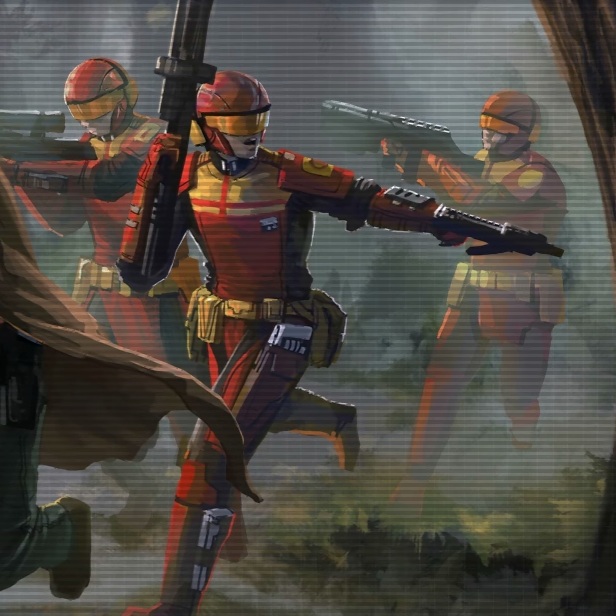
However, the Battle of Jaga's Cluster ended in disaster. Despite the presence of Revan and Malak, Cassus Fett's forces emerged victorious, and Fett gained notoriety for personally boarding one of the Republic flagships and killing the captain. Shortly afterward, at the Battle of Althir, forces under Revan's command annihilated most of the Mandalorian ground forces, reclaiming the industrial world after approximately twenty-five years of Mandalorian control. Late in the Mandalorian Wars, Revan ordered his forces to retake the planet Onderon and its moon Dxun, which was a heavily fortified Mandalorian stronghold. A large-scale assault was organized to take Dxun, though the offensive was incredibly costly to the Republic. The enemy had decades to fortify the moon, with defenses that included minefields, traps, anti-air turrets, and the jungle beasts themselves.
Revan's battle plan called for battle droids to be deployed on the moon to eliminate the anti-air turrets, after which his forces—under the command of the Jedi General Meetra Surik—undertook hundreds of small-unit feints to probe the Mandalorian defenses. Surik lost most of her forces when they charged across a minefield in an attempt to strike at the Mandalorian emplacements, but she carried out Revan's plans regardless. The battle lasted for months as the Mandalorians refused to surrender, resulting in incredibly high casualties. Veterans of the battle stated that the Republic lost ten soldiers for every Mandalorian killed. Despite the cost, the Republic ultimately captured the moon, driving the Mandalorians back toward the Outer Rim.
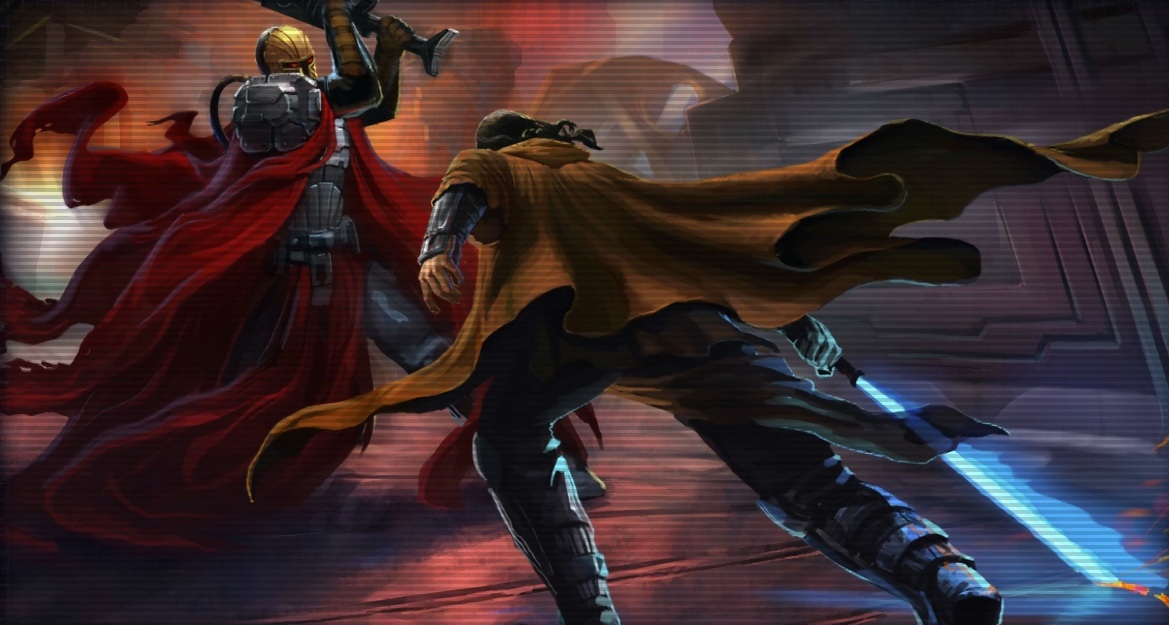
In 3960 BBY, the Republic, spearheaded by Revan, successfully reclaimed the Lianna system, pushing the Mandalorians back further and further. To decisively end the war, Revan orchestrated a final confrontation at Malachor V, drawing the Mandalorians into an ambush by deploying a substantial fleet to the planet. Crucially, Revan had secretly prepared a devastating weapon of mass destruction: the Mass Shadow Generator, a gravity-based weapon designed by the Zabrak mechanical expert Bao-Dur. This generator was intended to be the pivotal element of the trap on Malachor, where Revan aimed to conclude the war. Revan divided his forces, entrusting half to Meetra Surik with the mission of luring the Mandalorians within range of the superweapon and activating it. However, Revan's arrival at the Malachor system was delayed due to an encounter with a Mandalorian scouting party, and by the time he reached the system, a major sea battle was raging between Mandalore the Ultimate's fleet and Surik's ships.
Realizing the Republic reinforcements made defeat unavoidable, Mandalore challenged Revan to a duel aboard his command ship. Revan accepted, boarding the vessel and engaging the warrior chieftain in a fight to the death. Despite Mandalore's power, Revan ultimately prevailed, defeating Mandalore, who fell at the Jedi's lower limbs. As the Taung choked on life fluid, he removed his helmet and revealed he had been deceived to Revan. Mandalore recounted the Sith's manipulation, the Sith's influence fading in his final moments, and provided the coordinates of Rekkiad as proof. Upon Mandalore's death, Revan claimed Mandalore's Mask, the symbol of Mandalorian leadership, as a prize, preventing the immediate appointment of a successor.
With Revan's triumph over Mandalore, the Republic forces intensified their assault on the Mandalorian fleet near Malachor V, but suffered considerable losses. This led Surik to order Bao-Dur to activate the Mass Shadow Generator. Both Revan's and Surik's ships were beyond the weapon's range, and they witnessed in horror as the majority of the Mandalorian fleet and a significant portion of the Republic fleet were pulled into a massive gravitational vortex. Tens of thousands perished as hundreds of ships crashed onto Malachor's surface, devastating the once-thriving world and shattering its core as the ships were compressed into the planet. While the Republic suffered substantial casualties, they were far fewer than those of the Mandalorians, and the immense loss of life created a significant disturbance in the Force. Surik, the Jedi closest to the vortex, instinctively severed her connection to the Force to survive the resulting shock wave. Following this devastation, the remaining Mandalorians offered their unconditional surrender to the Republic.
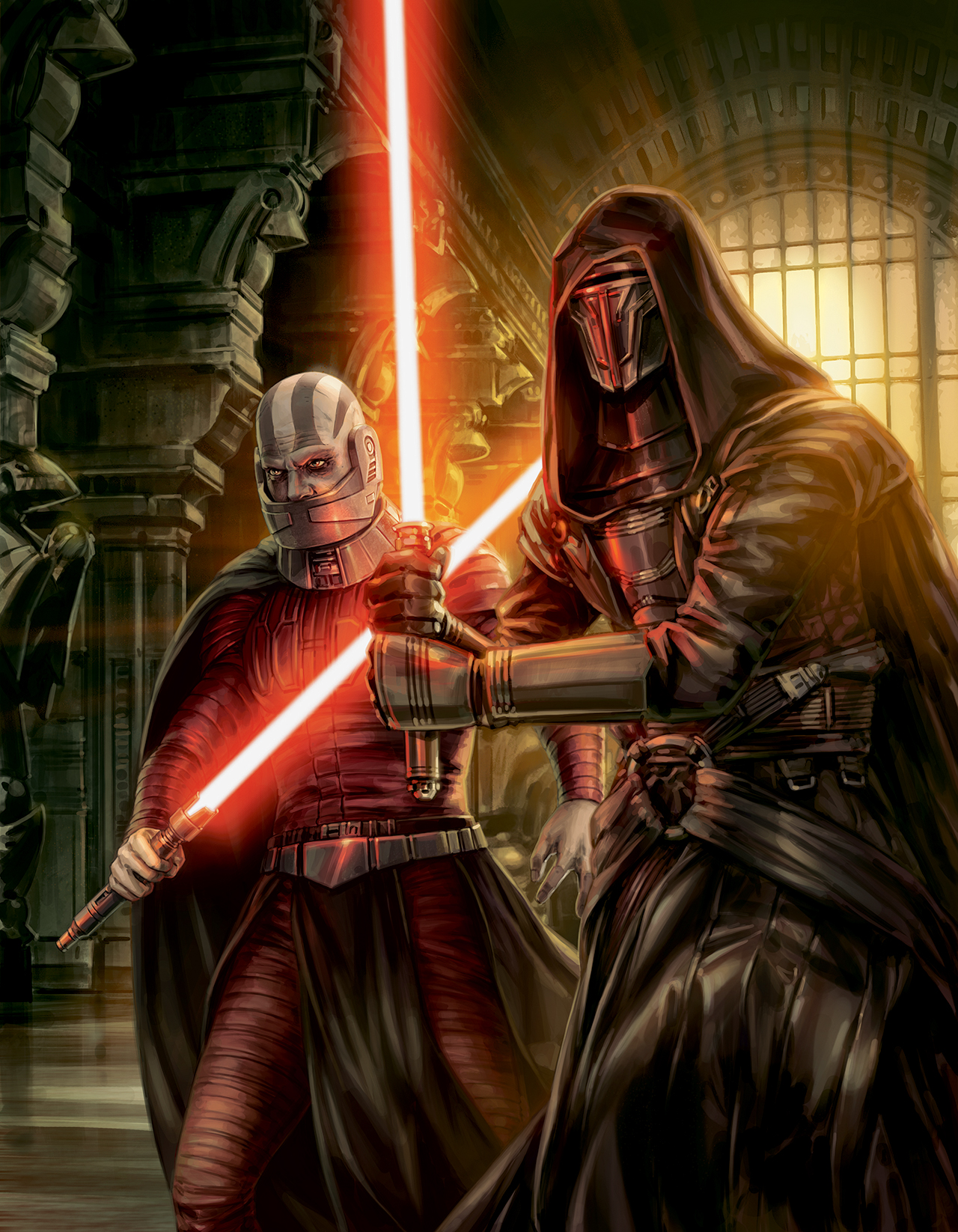
In the war's aftermath, the Jedi Council demanded that the surviving Revanchists—specifically, Revan, Malak, and Surik—return to Coruscant to be judged for their actions during the war's conclusion. Revan and Malak refused, leading the remaining forces into the Unknown Regions to the north, supposedly to pursue the remaining Mandalorians. Surik, now disconnected from the Force, chose to return to the Council. Malak urged Revan to use his new HK-47 assassination droid to eliminate Surik, but Revan declined, stating she was "already dead." Revan had created HK-47 to murder specific targets, aiming to avoid conflicts like Malachor. Revan and Malak soon abandoned their forces, traveling alone to Rekkiad to verify Mandalore's story. There, they found Dramath's tomb and a data storage device detailing Dramath's history and a hidden Sith Empire. Before leaving Rekkiad, Revan left Mandalore's Mask in Dramath's tomb.
Revan and Malak tracked the hidden Sith to their capital on Dromund Kaas, where they attempted to assassinate the Sith Emperor to prevent an invasion of the Republic. However, the Emperor controlled their minds, fully turning them to the dark side and making them his servants. Renaming them Darth Revan and Darth Malak, Dark Lords of the Sith, the Emperor sent them back as advance agents to invade the Republic, tasking them with finding the Star Forge. Unbeknownst to the Emperor, they broke free of his control shortly after leaving Dromund Kaas, adopting his commands as their own desires. Locating the Star Forge in the Unknown Regions, Revan and Malak used the space station to construct a vast fleet of warships, combining them with their followers from the Mandalorian Wars to create a new Sith state. Admiral Karath was among several high-ranking Republic military personnel who joined the new Sith, and in 3959 BBY, Revan led his Empire in invading the Republic. This subsequent conflict, known as the Jedi Civil War, lasted until 3956 BBY, when a redeemed Revan defeated his former apprentice at the Battle of Rakata Prime.
During the war, a group of displaced persons, including wealthy business people, crash-landed their vehicle on Makeb while fleeing Mandalorian raiders. Makeb, located far from major hyperspace routes, saw the survivors—led by business leader Semako Thalien—establish settlements and reconnect with the galaxy over the next fifty years. Utilizing the planet's abundant earth matter and their own currency and influence, they transformed Makeb into a highly profitable world. Remaining largely independent from the Republic, Makeb attracted corporate executives, banking institutions, and affluent tourists, developing numerous luxury resorts. The Interdictor technology, the basis for the Interdictor-class cruiser and the Mass Shadow Generator, was developed by Zabrak engineers during the conflict and became a common tactic in the thousands of years after the Mandalorian Wars. Interdictor technology, particularly ship-based gravitational wells, spurred advancements and countermeasures over millennia. The relatively weak Interdictors of the Mandalorian Wars were soon rendered ineffective by improved hyperdrive detectors and multiphase null field units, and the Clone Wars nearly four thousand years later inspired renewed research. Ion weapons also saw increased use during and after the Mandalorian Wars, proving effective in disabling Mandalorian raider weaponry.
Millennia later, during the era of the Galactic Empire, scientist Bevel Lemelisk included the Mass Shadow Generator in a list of historical superweapons in Imperial Handbook: A Commander's Guide. However, by then, the precise details of the weapon's effect on Malachor V were unknown, though the planet had long been destroyed. As a defining conflict of its time, the Mandalorian Wars were frequently referenced in scholarly works. Jedi Master Gnost-Dural briefly mentioned it while documenting his investigations into the Mandalorians of his era, and historical expert Vilnau Teupt discussed the conflict during his speech "Industry, Honor, Savagery: Shaping the Mandalorian Soul" in 24 ABY.
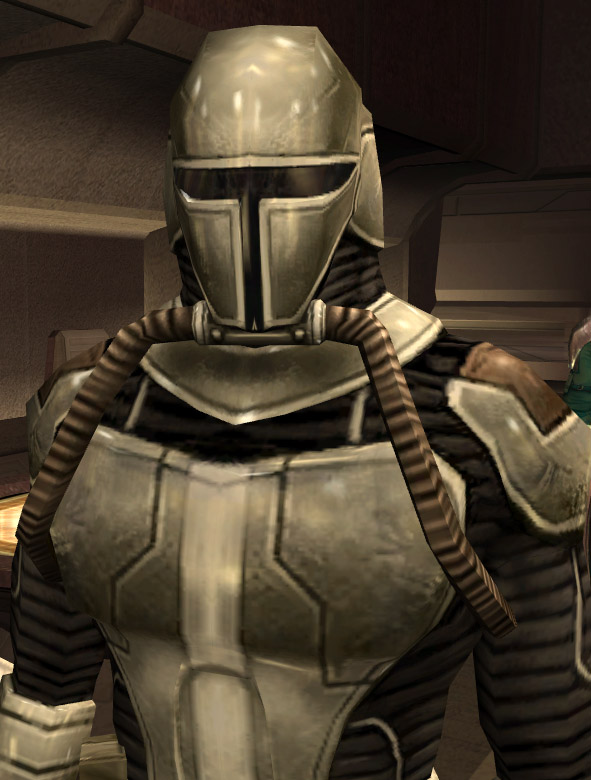
In the weeks following the Battle of Malachor V—known as Ani'la Akaan, or the Great Last Battle, in Mando'a—Revan ordered the disarmament of the remaining Mandalorians, including the dismantling of their basilisk war droids. To prevent renewed conflict, Revan kept Mandalore's Mask, its loss significantly demoralizing the Mandalorians. Most warriors became mercenaries or reward hunters as the clans largely disintegrated. Without the Mask, the clans fought among themselves for dominance. Over the years, some Mandalorian clans, like Clan Ordo, began searching for the Mask, identifying potential worlds Revan could have reached in the three days after Malachor. Initially, fewer than fifty Mandalorians searched the first world over two years, but their numbers grew as more clans joined the search across different planets. The search for the Mask united the Mandalorian clans behind a common goal, and by 3954 BBY, over a hundred clans were searching Rekkiad.
Revan, suffering from amnesia after the Jedi Civil War, sought help from his friend Canderous Ordo—a former companion during the Jedi Civil War—to investigate his returning memories in 3954 BBY. They traveled to Rekkiad to join the search. With Revan's assistance, Clan Ordo found the Mask in Dramath's tomb, and Revan convinced Ordo to become Mandalore the Preserver. Before leaving to retrace his and Malak's steps into the Unknown Regions, Revan tasked the new Mandalore with restoring Mandalorian strength to protect the Republic from the mysterious Sith threat. The Preserver spent the following years reuniting the clans and rebuilding their military, establishing a headquarters on Dxun and reviving the Neo-Crusader movement. In the Dark Wars after the Jedi Civil War, one of the new Sith Lords, Darth Nihilus, was a survivor of the Battle of Malachor, transformed by the experience into a being craving Force power and a living wound in the Force. Nihilus used the Force to raise the Ravager, a Centurion-class warship destroyed in the Battle of Malachor V, from the planet's surface and used it as his flagship. The Ravager was eventually destroyed by Republic and Mandalorian forces, with Mandalore the Preserver accompanying Meetra Surik—now known as the Jedi Exile—in a final assault on the ship as his forces fought alongside the Republic.
Despite the failure of the Mandalorian Wars, Mandalore the Ultimate's reforms had a lasting impact on Mandalorian society. The Taung species became nearly extinct, with the clans becoming Human-dominated and accepting warriors who proved their worth. In Mandalorian culture, a ritual called the Geroya be Haran, or "game of annihilation," emerged in the hundreds of years following the Mandalorian Wars. The loser's legacy was erased, symbolizing the Neo-Crusaders' victories during the Mandalorian Wars. However, Mandalore the Preserver was the last Mandalore to wear Mandalore's Mask, which disappeared after his death. Many clans grew rich from looting during the Mandalorian Wars but lost their wealth afterward, longing for a return to war.
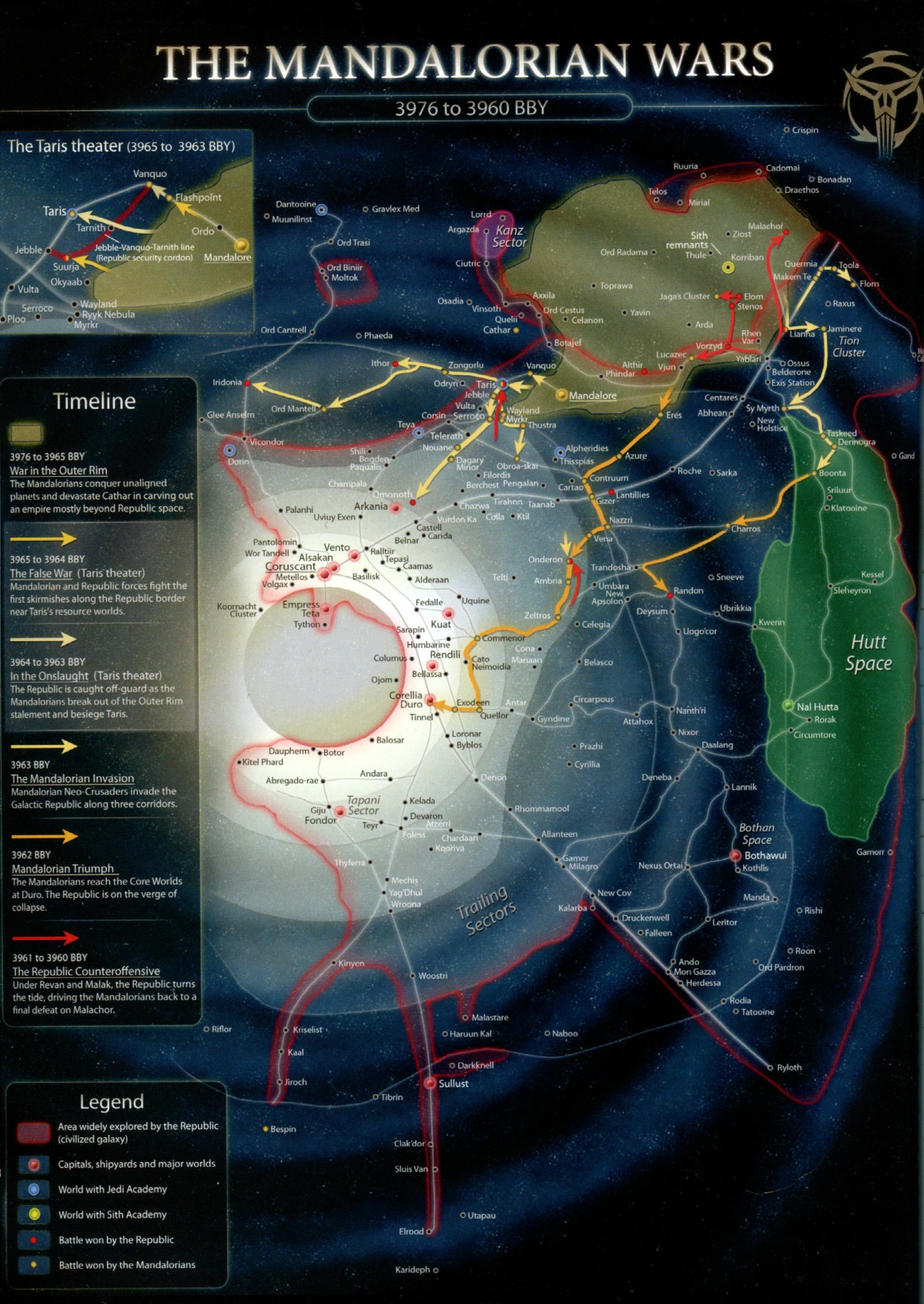
The Mandalorian Wars were initially mentioned in the computer game Star Wars: Knights of the Old Republic, released by BioWare in 2003. The conflict served as backstory for key characters like Darth Malak, Revan, and Canderous Ordo, and was further developed in the game's 2004 sequel, Star Wars: Knights of the Old Republic II: The Sith Lords. Beyond video game material, the conflict was not widely addressed until late 2005, when it was discussed in The New Essential Chronology. The Knights of the Old Republic illustrated story series, beginning in 2006, provided the first visual depictions of the conflict. Battles appeared in various story arcs, starting with issue 6. John Jackson Miller, the series' author, used the comics to develop the Mandalorians as a fighting force, evolving them from the individualistic warriors in the Star Wars: Tales of the Jedi comic series and the uniform, hue-coded soldiers in the Knights of the Old Republic video games.
The conflict's starting date has varied across sources. The Knights of the Old Republic game provides two dates: 3976 BBY, according to the Mandalorians, and 3963 BBY, according to the Republic. However, The New Essential Chronology and The Ultimate Visual Guide placed the endpoints at 3995 BBY and 3961 BBY, respectively. The Knights of the Old Republic comic series reconciled the conflicting dates, explaining that the Mandalorians had been raiding for years before the "False War" of 3965–3964 BBY, after which armed conflict broke out between the Republic and Mandalorians in 3963 BBY. The Knights of the Old Republic Campaign Guide, released in 2008, placed the Battle of Malachor V in 3960 BBY instead of 3961 BBY and included the False War by setting the start date as 3965 BBY. The Campaign Guide explained that the Mandalorians had been raiding Outer Rim worlds since 3976 BBY, but the Republic did not engage until 3965 BBY, with the true invasion beginning in late 3964 BBY. The 2009 reference guide The Essential Atlas reaffirmed the Campaign Guide's dating and detailed the main Mandalorian Wars, introducing new battles on a map of the conflict.
The three invasion corridors used by the Mandalorians during the Onslaught have caused some confusion. The Essential Atlas features a map showing three campaigns spreading from Taris, aligning with Canderous Ordo's statement that the Mandalorians invaded through three adjacent sectors. The 2012 reference guide The Essential Guide to Warfare identifies the corridors as the northern campaign, the Coreward campaign including Serroco, and the southern campaign starting with Eres II. However, Eres is part of the Mandalorian Triumph, which begins in 3962 BBY. As Warfare's section is presented as an internal oral presentation given thousands of years later, the account may not be entirely accurate. The Atlas's map also shows a campaign on the eastern edge of the galaxy in 3963 BBY, not mentioned elsewhere. However, the text indicates those battles occurred earlier, during the decade-long buildup, supported by Warfare and The New Essential Chronology.
The Complete Star Wars Encyclopedia, published in 2008, mentions the conflict in various entries, but contains some errors. Cassus Fett's entry incorrectly states the Battle of Jaga's Cluster occurred before the Mandalorian Wars, contradicted by other entries. Another issue concerns when the Revanchists joined the Republic Military. According to Bastila Shan's dialogue, the Revanchists joined five years before the game, set in 3956 BBY—placing their entry in 3961 BBY. However, later sources place it in 3963 BBY. The Essential Guide to Warfare attempted to reconcile this, explaining that Revan was appointed Supreme Commander in 3962 BBY.